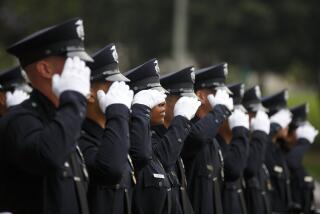Stickers Settle Ansel Adams Photos Suit : Judge Orders Calendars Labeled as Not Using Original Pictures
- Share via
A federal judge Friday ordered a Santa Barbara publishing company to paste stickers on more than 60,000 desk and wall calendars featuring photographs taken by the late Ansel Adams to warn customers that the pictures are made from reprints, not original Adams works.
The order, issued by U.S. District Judge William D. Keller, represented a partial victory for Adams’ estate and his long-time publisher, Boston-based Little, Brown and Co., in a lawsuit against Day Dream Publishing Inc., which produced a book of the reproduced Adams photographs earlier this year and is distributing the line of 1990 calendars.
“There’s something you can’t do,” Keller told Day Dream’s lawyers in a ruling issued from the bench. “You can’t pass off (reconstituted photos as original) and mislead, knowingly or unwittingly, the purchasing public.”
The book and the calendars bear the title, “The Mural Project.” They include pictures made by re-photographing images printed by Adams for the U.S. Interior Department in 1941 and 1942.
Distribution and promotion of the book was not affected by Friday’s ruling because attorneys for Adams’ estate and publishing company conceded that virtually all copies are already on store shelves or sold. The attorneys had argued for greater court sanctions, but Keller ruled that they had not proven that the typographical design of the calendars and the book was illegally similar to designs used for Adams’ works by Little, Brown.
In issuing the injunction, Keller also offered a novel, court-sanctioned definition of what can be called an Ansel Adams photograph.
For a photograph to be advertised and promoted as Adams’ own work, Keller said, the image would have to be representative of Adams’ style of subject selection and picture composition--characterized by waiting for just the right shadow and lighting conditions.
The photograph would have to have been made with focus, shutter speed and depth-of-field characteristics identified with Adams. The negative would have to have been developed by Adams, and the print made from the original negative using printing techniques developed by Adams that rely on a unique reproduction of gray tones in black and white images.
Strike a Balance
Keller said he developed the definition in an attempt to strike a balance between the right to use artworks that are in the public domain--as the entire Mural Project series is--and an artist’s right to safeguard the integrity of his work.
In ordering the injunction, Keller concluded that Day Dream had engaged in promotion and advertising of its Ansel Adams product line that is “misleading, calculated (to), and will in all probability, create confusion in the general population.”
Attorneys for the Ansel Adams Publishing Rights Trust and Little, Brown filed the court action after Day Dream announced it would publish the Adams photos in the book.
But Day Dream said only about half of the 1990 calendar line--a total of 122,000 copies--had been shipped. Keller’s order requires Day Dream to place disclaimer stickers declaring that the images they present were “printed from copies of Ansel Adams photographs” on all copies remaining in warehouses. The requirement includes an estimated 8,000 to 10,000 that are already boxed and await shipment to such retailers as Waldenbooks, B Dalton Bookseller and Doubleday Book Shops.
A set of prints made by Adams of the 225 images in the Mural Project series is in the custody of the National Archives in Washington. Anyone can order prints for about $5 a photograph by writing to the federal facility.
Remain in Vault
The original negatives for the series remain in Adams’ vault in Carmel Highlands, Calif. The custody and status of the negatives has emerged as an emotionally charged side issue in the legal dispute but is not officially a part of the lawsuit.
Adams, who died in 1984, had been hired to produce a series of more than 200 photographs of national park scenes for possible use as murals in Interior Department buildings. The mural prints were never executed.
More to Read
Sign up for our Book Club newsletter
Get the latest news, events and more from the Los Angeles Times Book Club, and help us get L.A. reading and talking.
You may occasionally receive promotional content from the Los Angeles Times.







